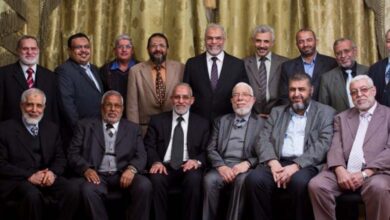Where is Sinwar in the Gaza Negotiations? Hamas Leader Reveals His Role and Communication Methods

More than two weeks after Hamas appointed Yahya Sinwar as the head of its political bureau in Gaza, succeeding Ismail Haniyeh, questions have arisen about his role in negotiations for ending the war and exchanging hostages.
-
Between Sinwar’s Approval and Israel’s Rejection… An Uncertain Fate Awaits Gaza Truce Negotiation
-
The Muslim Brotherhood blesses the appointment of Sinwar… An expert affirms it is illegitimate and contrary to the regulations of Hamas and the Muslim Brotherhood
This role was revealed by Osama Hamdan, a senior Hamas leader, on Monday in an interview with Reuters, stating that “the movement’s new leader, Yahya Sinwar, was closely involved in the negotiation process (regarding the Gaza ceasefire agreement), blessed it, and was a partner in making the decisions related to it.”
Hamdan added, “Communication with Sinwar has its own tools and mechanisms, and of course, security conditions impact our efforts to ensure that the enemy (the Israeli army) doesn’t target Sinwar.“
He continued, “However, these communications with Sinwar are smooth, satisfactory, and achieve their intended goal.”
-
Blinken urges Sinwar to reach an agreement with Israel to halt Gaza war
-
In a message to the arabs… Sinwar reveals Hamas’s stance on Biden’s plan to end the Gaza War
Israel believes that Yahya Sinwar has been hiding since the war broke out on October 7 in a vast network of tunnels stretching deep beneath cities and refugee camps in the Gaza Strip.
It is said that Sinwar no longer trusts electronic communications, fearing the Israeli army could locate and kill him.
Instead, he delivers oral instructions and messages to trusted individuals, who then convey them to Hamas leadership.
-
Sinwar’s Movements Disrupt Israeli Equations, Not in Rafah
-
Sources: Is Israel Close to Knowing the Location of Hamas Leader Sinwar?
Criticism of Blinken
Hamdan criticized U.S. Secretary of State Antony Blinken‘s statement that Israeli Prime Minister Benjamin Netanyahu had accepted a revised proposal.
He said it “creates a lot of confusion” because “this is not the document that was presented to us nor the one that Hamas agreed upon.”
Hamdan told Reuters that “Hamas has already confirmed to mediators that it does not need new negotiations or new ideas. There is a proposal that we have agreed on, and we need to implement it, which is also based on President Joe Biden’s proposal.”
-
Hamas is looking for an alternative to Sinwar… Is this the first candidate?
-
Leadership du Hamas seeks to disavow and hold Sinwar accountable to facilitate a ceasefire agreement
Washington’s Proposal
Blinken stated on Monday that “Israeli Prime Minister Benjamin Netanyahu accepted a proposal put forward by Washington for a ceasefire in Gaza, calling on Hamas to accept it as well.”
He added during a press conference in Tel Aviv, “During a very constructive meeting with Prime Minister Netanyahu today, he confirmed to me that Israel accepts the proposal to bridge the gaps and that he supports it.”
He continued, “Hamas must now do the same, and then both parties, with the help of mediators – the U.S., Egypt, and Qatar – need to sit down and finalize clear understandings on how to implement the commitments agreed upon in this deal.”
-
Ending the Gaza war: Sinwar seeks resolution based on an organized plan
-
Israel Announces End of Military Operations in Gaza
Blinken made these statements after a day of meetings with Israeli officials, including a two-and-a-half-hour meeting with Netanyahu, which Blinken described as “very constructive.”
Earlier, he had said that these efforts might be the best and last chance to reach an agreement.
Talks held last week in Qatar to reach a ceasefire and hostage exchange deal did not yield results, but negotiations are expected to resume this week, based on an American proposal aimed at bridging gaps between Hamas and Israel.
-
Illusory Optimism or New Pressures: What Lies Behind American Claims About Ceasefire Negotiations in Gaza?
-
Tough-Talking Haniyeh Was Seen as the More Moderate Face of Hamas
Blinken’s visit comes as U.S. President Joe Biden faces growing pressure in an election year over his stance on the conflict.
His Democratic Party is starting its national convention today amidst pro-Palestinian protests and concerns over the Muslim and Arab-American vote in key states.
Few signs point to a breakthrough, as Hamas announced the resumption of attacks in Israel after a long pause, claiming responsibility for an attack in Tel Aviv on Sunday. Meanwhile, rescue workers said Israeli military strikes killed at least 30 Palestinians in Gaza that same day.
-
Gaza Tunnels: Changing the direction of wars?
-
Contradictory European Stances on ICC Warrant Against Netanyahu
Tough Negotiations
Despite the optimism expressed by the U.S. and Netanyahu’s office describing the meeting as positive, both Israel and Hamas have signaled that reaching an agreement will be tough.
The sporadic discussions, ongoing for months, revolve around the same issues: Israel insists the war can only end by dismantling Hamas as a military and political force, while Hamas demands a permanent, not temporary, ceasefire.
There are also disagreements over the Israeli military presence in Gaza, particularly at the Egypt border, the freedom of movement for Palestinians within the territory, and the identity and number of prisoners to be released in any hostage exchange.
-
Suspicious Relationship Between Israel and Hamas… Facts and Testimonies
-
Sharp disagreements among Hamas leaders over prisoner exchange deal
Blinken acknowledged the difficulty of the negotiations, saying: “The challenge is to get Hamas to agree to the proposal to bridge the gaps and ensure that there are clear understandings on how each party will abide by its commitments and effectively implement this deal.”
He added, “These are complex issues, but that’s why we have expert negotiators working on this issue… Prime Minister Netanyahu has committed to sending his team of senior experts to either Doha or Egypt to try to finalize this process.”
Hamas has accused Washington of bias toward Israel in the ceasefire negotiations.
-
Hezbollah was aware of Hamas’ attack half an hour before its execution
-
Netanyahu assures Qatar of not assassinating Hamas leaders in Doha… Details
Sami Abu Zuhri, a Hamas leader, told Reuters: “Blinken is acting as if he’s a minister in Netanyahu’s government, so we do not expect any positive change in the American position.”
The conflict between Israel and Hamas erupted on October 7, when Hamas launched an attack on Israel, which they claim killed 1,200 people and took about 250 hostages.
Since then, the Israeli military campaign in Gaza has left vast areas of the territory in ruins, killed at least 40,000 people according to Palestinian health authorities, displaced almost the entire population of 2.3 million people, and driven hunger and disease rates to critical levels.
-
Israeli Military Expert: Hamas far from surrender and collapse
-
Israel is considering a settlement that involves deporting leaders of Hamas abroad
The conflict has pushed the entire Middle East to the brink of disaster, triggering months of cross-border clashes between Israel and Hezbollah in Lebanon and raising fears of a regional escalation that could draw in global powers.












